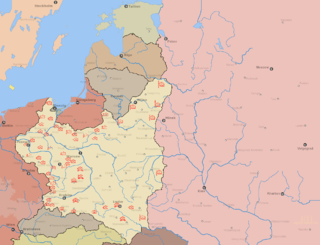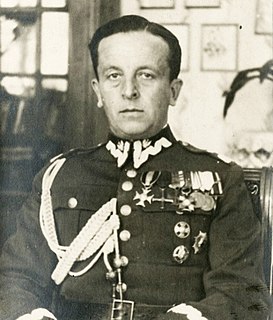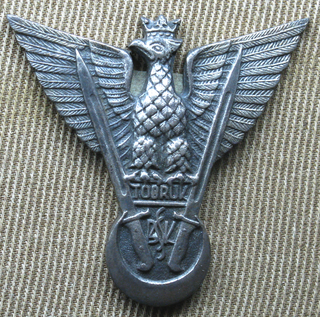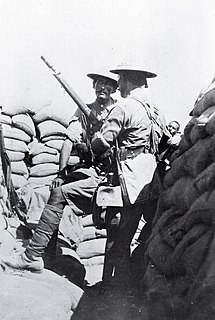Related Research Articles

The charge at Krojanty, battle of Krojanty, the riding of Krojanty or skirmish of Krojanty was a cavalry charge that occurred during the invasion of Poland in the Second World War. It took place on the evening of 1 September 1939 near the Pomeranian village of Krojanty. Polish soldiers advanced east along the former Prussian Eastern Railway to railroad crossroads 7 kilometres from the town of Chojnice (Konitz) where elements of the Polish cavalry charged and dispersed a German infantry battalion. Machine gun fire from German armoured cars that appeared from a nearby forest forced the Poles to retreat. However, the attack successfully delayed the German advance, allowing the Polish 1st Rifle battalion and Czersk Operational Group to withdraw safely.
The South African 2nd Infantry Division was an infantry division of the army of the Union of South Africa during World War II. The division was formed on 23 October 1940 and served in the Western Desert Campaign and was captured by German and Italian forces at Tobruk on 21 June 1942. The remaining brigade was re-allocated to the South African 1st Infantry Division.

Polish OOB during the invasion of Poland. In the late thirties Polish headquarters prepared "Plan Zachód", a plan of mobilization of Polish Army in case of war with Germany. Earlier, the Poles did not regard the Germans as their main threat, priority was given to threat from the Soviets.

Stanisław Grzmot-Skotnicki was a Polish military commander and a general of the Polish Army. During the invasion of Poland of 1939 he commanded the Czersk Operational Group and was among the highest ranking Polish officers to be killed in action in that war.

Polish Independent Carpathian Brigade was a Polish military unit formed in 1940 in French Syria composed of the Polish soldiers exiled after the invasion of Poland in 1939 as part of the Polish Army in France. It was commanded by General Stanisław Kopański.

The Volhynian Cavalry Brigade was a Polish cavalry brigade, which saw action against the invading Germans during the Invasion of Poland, a part of World War II. Raised from recruits in the area of Wołyń, the division was posted to the Łódź Army. During several desperate counter-attacks, the brigade suffered heavy casualties near Łódź. It was commanded by Colonel Julian Filipowicz. Most notably, the unit took part in one of the first battles of the German invasion of Poland, the battle of Mokra.

The Battle of Mokra took place on September 1, 1939 near the village of Mokra, 5 km north from Kłobuck, 23 km north-west from Częstochowa, Poland. It was one of the first battles of the Invasion of Poland, of the Second World War and one of the few Polish victories of that campaign, as well as the first German defeat of the conflict.
The 16th Pomeranian Infantry Division is a military unit of the Polish Army. It was first raised on 16 August 1919 during the Polish uprising, before going on to serve during the subsequent war with the Bolsheviks. At the start of World War II the division fought briefly against the advancing German Army before being destroyed on 19 September 1939 after being surrounded in the Kampinos Forest. The Division was raised once more in 1945 following the Soviet take over of Poland, however, it did not see further action during the war. Afterwards it continued to serve, undergoing a number of changes in name and role. Today, it exists as the 16th Mechanised Division.
Land Coastal Defence, commanded by Colonel Stanisław Dąbek, was an important unit tasked with the defence of Poland's Baltic Sea coast during the 1939 invasion.
The Warszawa Army was one of the Polish armies to take part in the Polish Defensive War of 1939. Created on 8 September, eight days after the invasion begun, it was an improvised formation charged with the defence of the Polish capital of Warsaw (Warszawa).
Iraqforce was a British and Commonwealth formation that came together in the Kingdom of Iraq. The formation fought in the Middle East during World War II.
The Second Battle of El Alamein order of battle is a listing of the significant formations that were involved in the Second Battle of El Alamein during the Western Desert Campaign of the Second World War, 23 October – 4 November 1942.
The Order of battle of the East African campaign shows the ground forces of both sides in East Africa on the date that the Italians declared war on Britain and France, 10 June 1940 and for the British and Commonwealth forces involved in the 1941 offensive.

Pomeranian Cavalry Brigade was a cavalry unit of the Polish Army in the interbellum period. It was created on April 1, 1937 out of the Cavalry Brigade "Bydgoszcz". Its headquarters were stationed in Bydgoszcz and the brigade consisted of these units:

The 7th (Meerut) Division was an infantry division of the British Indian Army that saw active service during World War I.
The 3rd (Lahore) Division was an infantry division of the British Indian Army, first organised in 1852. It saw service during World War I as part of the Indian Corps in France before being moved to the Middle East where it fought against troops of the Ottoman Empire.

15th Poznań Uhlan Regiment – unit of Polish cavalry, part of Greater Polands Army, Polish Army of Second Republic and Polish Armed Forces in the West during World War II.
In September 1939, the British Army was in process of expanding their anti-aircraft and mobile assets. Among these new changes was the formation of Anti-Aircraft Command which was formed on 1 April 1939, and the 1st Armoured Division formed in 1937. The list below will include the British Army units, colonial units, and those units which were in the process of formation.

The Intervention Corps was a tactical unit of the Polish Army in the Second Polish Republic. It did not exist in the peacetime organization of the Polish Army, and was created for specific purposes only. Its task was to intervene in special circumstances, both inside Poland and outside of the country.
The Order of battle, Keren 1941 shows Italian army forces that participated in the Battle of Keren from February to March 1941 and British troops in Sudan on 20 January 1941, which participated in military operations against Eritrea during the East African Campaign 1940–1941.
References
- Ciechanowski, Konrad (1983). Armia "Pomorze" (in Polish). Warsaw: Wydawnictwo MON. ISBN 83-11-06793-7.